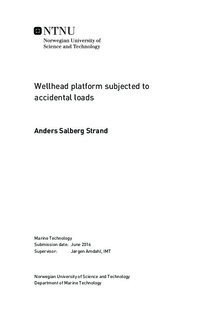| dc.description.abstract | Cost reduction in the oil and gas industry forces new and innovative solutions.
Unmanned wellhead platforms are alternative solutions for developing small fields
which would normally be developed with subsea wellheads. For an installation to
be approved to operate on the Norwegian Continental Shelf, it must be designed
against accidental actions such as fire.
Current rules regarding design against fire loads has been reviewed, showing examples
of heat transfer hand calculations, as well as material's strength degradation as
function of temperature.
A generic wellhead platform has been designed, based on comparable structures, and
simple hand calculations to have a reasonable model to work with. Conservativeness
has been applied to end up with a tough structure and reduce the need for passive
fire protection. The structure was tested against normal operational loads and were
proven to have more than sufficient resistance.
Operational-, variable maintenance- and accidental loads has been established with
help from Trond Granli in Kværner. Characteristic fire scenarios were provided and
cases set up.
A shell script has been adapted for use on the heat transfer and response simulations.
Trouble with multi- threading simulations prevented it from functioning perfectly,
but it worked for single- threading.
A large amount of simulations has been run, resulting in the conclusion that loads
relating to wireline well intervention operations in combination with moderate jet
fires is survived by the structure. Reserve strength ratios in the range above 4.5 were
exhibited. The case of accidental jack- up rig cantilever collapse was shown to be
tolerated, and the case involving a large jet fire inside the platform also survived the
duration of the characteristic fire scenario. But further simulations are recommended
to confirm. Temperature- domain simulations has been run to validate a few of the
pushdown simulations, with promising results.
A good pool fire model was not established, but was simulated with the standard
hydrocarbon temperature curve. The results showed adequately strength after the
duration of the fire. | |

